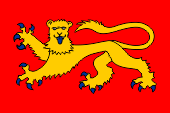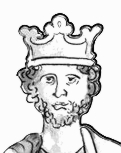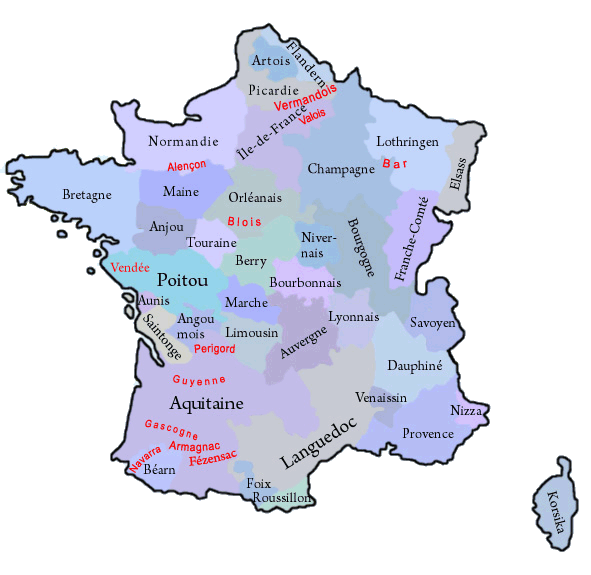mobile View, to the German Version tap the flag


- historical region in France
- former kingdom, duchy and province
• Flag
• Meaning/Origin of the Flag
• Coat of Arms
• Meaning/Origin of the Coat of Arms
• Map of the historical Regions in France
• Explanations about the Regions
• History
• Origin of the Country's Name

Flag of Aquitaine – Drapeau de l'Aquitaine,
Source, by:
Wikipedia (D)






1960–2016,
Unofficial flag of the Region of Aquitaine
– Drapeau de officieux de la Region Aquitaine,
Source, by:
Wikipedia (D)






The flag of Aquitaine is a scutcheon-flag, its design is the image of the coat of arms of Aquitaine. The in 1960 created Region of "Aquitaine" uses this model as unofficial flag.
Source:
Volker Preuß,
Wikipedia (D)


Coat of arms of Aquitaine – Blason du Aquitaine,
Source, by:
Heraldique Europeenne

The coat of arms of Aquitaine shows a golden leopard on red. About the origin of the coat of arms is nothing known. It is interesting that the Normandy uses the same coat of arms image, but with two leopards, and the kingship of England with three leopards. After all, it is possible that the coat of arms was introduced by Henry Plantagenet, who came by marriage to Aquitaine in 1152. Already in 1144 he had become Duke of Normandy, and introduced there the coat of arms with the three leopards, which were reduced to two in 1194, and the coat of arms with the three leopards was reserved for the kingship of England, and those one with the one Leopard for Aquitaine. As in 1259 the Duchy of Guyenne was created – the English crown lost Aquitaine – the coat of arms of Aquitaine was maintained there.
Source:
Heraldique Europeenne,
Volker Preuß

 Read here:
Read here:
A flag affair!
"From a royal banner-throw to being held hostage". The problems of Richard I. (the Lionheart), King of England, with an unloved flag!

The historical, French Regions:

in black: governorate and province in 1776,
in red: former county, province oder governorate
Map: Volker Preuß

The until the French Revolution existing provinces (or governorates) have been historically grown structures, which had their roots oftenly in former fiefdoms of the French crown, historic counties and duchies. They oftenly existed for hundreds of years and had preserved regionality (e.g. cultural particularities and regional languages). On the occasion of the French Revolution such phenomena were of course not desirable, and as part of their bloody and violent egalitarianism any regional references were eliminated. Shortly after the French Revolution the provinces were dissolved and France became divided into many départements, which should have approximately the same size and the same status. The départements were named after rivers or mountains, to use never and in no circumstances the name of an old province. However, there was no success in cutting the connections of the people of France to their respective regions, so that administrative regions were re-created in 1960, to have a better control in regional administrative processes. In this way became départements, which were placed in a historical province, administratively grouped to an oftenly historically named region. The resulted structures coincide only approximately with the boundaries of the old provinces. In the strictly centralist France any regionality is avoided, so that even the official flags of these regions mostly look like flags of companies, unloving, unhistorical, technocratic and modernistic, and these flags should not be a subject of any lexical considerations here. Only in a few of that regions, exist official flags which remember the historical models. But, even the existence of these today's regions is douptful, because in 2014 was passed a territorial reform valid from the year 2016, that reduces the number of the existing regions by merging to nearly the half. However, there exist unofficial flags in nearly all of these regions, which should remember the old provinces and the old heraldry.
Wikipedia Link to the regions of France:
click or tap here
FOTW Link to the regions of France:
click or tap here
Source: Flags of the World,
Wikipedia (D),
Volker Preuß

antiquity · colonization by Iberian and Celtic tribes, the largest are the Auskers and Bituriges
52 B.C. · Roman conquest, forming of the province of Aquitania in the west of Gaul
418 A.D. · the Visigoths be settled as federates
5th century A.D. · conquest of Gaul by the Franks (under King Clovis) to 507 conquest of Aquitaine, expansion of the empire to the Atlantic Ocean, the Pyrenees and the Alps
6th century · the Basques (Vascons) expand their influence in the northern Foothills of the Pyrenees and immigrate, they establish their Duchy of Vasconia (" Gascogne ") in southern Aquitaine
511 · death of King Clovis, division of the Frankish Empire by Salic law of succession among his four sons (residences in Paris, Soissons, Orléans, Reims)
ca. 550 · administrative division of the empire into the kingdoms of Austrasia and Neustria, and the Duchy of Aquitaine and the Kingdom of Burgundy
639 · death of King Dagobert I., the power goes over to the Mayors of the Palace (maior domus) of Austrasia (House of the Carolingians)
687 · Pepin II. asserts itself as Mayor of the Palace throughout the Frankish Empire
8th century · the Moors (Islamic Arabs from North Africa) expand their influence in the northern Foothills of the Pyrenees, Duke Eudes calls Charles Martel to help
732 · Battle of Tours and Poitiers, Charles Martel defeats the Moors, they are pushed back over the Pyrenees, in the following years, however, fights between the Dukes and the Frankish kings
751 · Pepin the Short (III., grandson of Pepin II.) eliminates the Merovingian monarchy and let hisself elect to the king from the Franks
771 · Charlemagne takes over Aquitaine and transmits it later as a kingdom to his youngest son Louis the Pious
814 · Louis the Pious hands over Aquitaine (and the Spanish March) to his son Pippin
817 · Pepin is king of Aquitaine, a few years later Louis the Pious transfers Aquitaine to his youngest son, Charles (Charles the Bald), who has difficulties to prevail as king in Aquitaine
843 · division of the Frankish Empire (Treaty of Verdun), there arise the West Frankish Kingdom of Charles II. (the Bald), the Middle Frankish Kingdom of Lothar (Lotharingia), and the East Frankish Kingdom of Louis II., Aquitaine comes to the Empire of Charles the Bald, However, there is resistance among the nobility, they prefer Pepin II. (son of ex-King Pepin)
845 · Charles the Bald sets Pepin II. as king in Aquitaine, but without Poitou, Saintonge and Angoumois
849 · election of Charles the Bald as King of Aquitaine
855 · Charles the Bald lets elect his son Charles to the King of Aquitaine
867 · Death of King Charles, he is succeeded by his brother Louis (Louis the Stammerer)
870 · at the division of the Frankish Empire (Treaty of Meersen) arises the West Frankish Kingdom, the East Frankish Kingdom, and the Frankish Kingdom of Italy
877 · Ludwig ascends the West Frankish throne, Aquitaine is given as a fief and a duchy to Rainulf, Count of Poitiers, (House of the Ramnulfids)
880 · by the division of the Frankish Empire (Treaties of Verdun and Ribbemont) arises the West Frankish Kingdom (later France), the East Frankish Kingdom (later German Empire), the Kingdom of Italy, the Kingdom of Upper Burgundy (under Rudolf the Welf) and the Kingdom of Lower Burgundy persists
898 · Odo, Count of Paris and Duke of Francia, is elected to the king of the East Frankish Empire, Rainulf takes over the title of the King of Aquitaine
909 · Aquitaine is a duchy again, under William the Pious (Williamids, Gellones)
927 · Aquitaine comes to the House of Poitou (Ramnulfids)
950 · Aquitaine includes now the counties of Gascony, Armagnac, Fézensac, Périgord, Poitou, Angoulême and La Marche
987 · death of the childless West Frankish King Louis V. (House of Carolingians), his heir and uncle Charles of Lower Lorraine could not prevail, the nobility elects Hugh Capet (House of Capet) to the king, the Capetians are the Kings of France to 1328 - the Count of Toulouse (actually a vassal of the king of France and Duke of Aquitaine) refuses the following to Hugh Capet, the County of Toulouse becomes thus quasi-independently, and in the following years it became more and more powerful, resulting in the 12th century in an competition and enmity to the Duchy of Aquitaine, that meanwhile became a part of the Angevin Empire of the powerful noble House of Plantagenet
1102 · Count Raymond of Toulouse, participant and leader of the First Crusade, founds in the Levant the County of Tipolis
1152 · Henry Plantagenet marries Duchess Eleanor of Aquitaine, the duchies of Aquitaine and Gascony come to the house of Anjou-Plantagenet
1154 · death of Stephen of Blois (King of England), Henry is his successor as Henry II., Anjou becomes in this way a fief of the French king, which is a part of the crown of England (House of Anjou-Plantagenet)
1204 · Philip Augustus, King of France, conquers Normandy, Anjou, Maine and Touraine (Angevin Empire of the Plantagenets)
1224 · King Louis VIII. of France, son of Philip Augustus, conquers Aquitaine, except Gascony the last possession of the Plantagenets in France, Poitou and Saintonge come directly to the crown, La Marche, Périgord, Angoulême and Auvergne become fiefs
1259 · Treaty of Paris (Abbeville), King Henry III. of England recognizes the loss of Aquitaine, and receives in this way the Saintonge, which is united with Gascony to the Duchy of Guyenne, as fief
1328 · death of King Charles IV. (the Fair), extinction of the direct Capetian line, according to Salic Law Count Philip of Valois (Son of Prince Charles of Valois, first cousin of King Charles IV.) came on the French throne (as King Philip VI .), the English king Edward III. lays claim to the throne as a maternal nephew of Charles IV., reason for the "Hundred Years War" (Anglo-French War, 1338–1453), out of the House of Valois came all kings of France from 1328 to 1589
1453 · Battle of Castillon, the end of the Hundred Years War, the Kings of England have to cede all their possessions in France, in this way the Guyenne comes finally to France, the country is connected to the royal domain, later establish of the province of Guyenne
1776 · the already in the 14th century created governorates of the civil administration of the kingdom of France become committed to a number of 39, and correspond in this way to the number of provinces, in previous years could any provinces be summarized in one governorate
1789 · French Revolution, the governorates and provinces become abolished, Aquitaine is divided into departments (approximately: Gironde, Dordogne, Lot, Aveyron, Landes, Lot-et-Garonne, Gers, Hautes-Pyrenees and Haute-Garonne)
1960 · reintroduction of regions in France, forming of the Aquitaine region (capital is Bordeaux), but not within the historic boundaries, just by integrating of the departments of Dordogne, Gironde, Landes, Lot-et-Garonne and Pyrénées-Atlantiques
2016 · the Aquitaine region merges with the Poitou-Charentes and Limousin regions in the new, larger region of New Aquitaine (Nouvelle-Aquitaine)
Source:
Wikipedia (D),
Meyers Konversationslexikon

The name "Aquitaine" was alredy given to the country by the Romans.
Source:
Volker Preuß


![]()










 Read here:
Read here:
